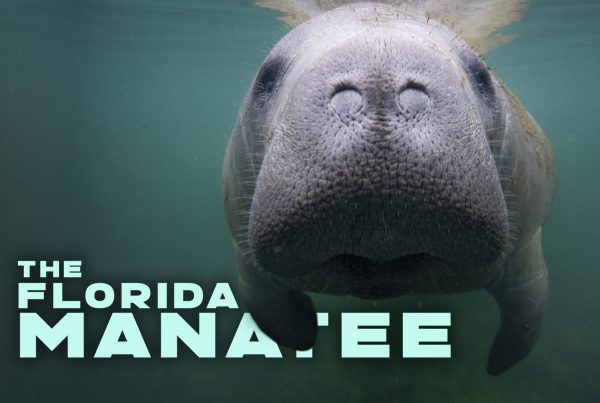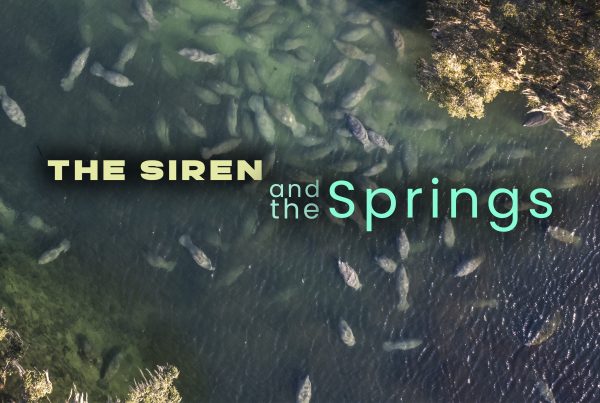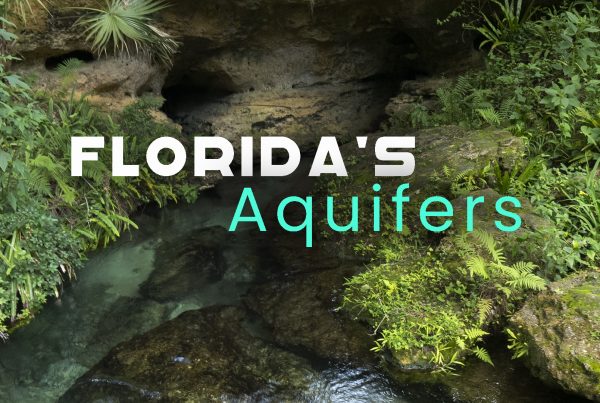An aquifer is basically a rocky sponge that holds groundwater. Most of us don’t think much about aquifers on a daily basis…. but we definitely should.
Download this PDF and use the vocabulary list to fill in the features in the appropriate places:
Vocabulary:
- Confined aquifer: an aquifer that is overlaid by a confining layer
- Surficial aquifer: a shallow aquifer with no confining layer.
- Water table: the upper surface of an aquifer’s zone of saturation
- Zone of saturation: the “wet” part of an aquifer. This is where the aquifer is completely saturated with groundwater
(Takes swig from water bottle) Mmmm, that hits the spot. Nothing beats a long swig of cold, fresh water in the Florida heat. H2O literally is the stuff of life, and this is why keeping our fresh water supplies clean and plentiful is something we need to take very seriously.
In this state, the purest, potable fresh water source is literally below our feet- our freshwater aquifers. “Potable,” by the way, basically means “safe to drink.”
So what is an aquifer? Well, a quick Wikipedia search pulls up the following definition: “An aquifer is an underground layer of water-bearing permeable rock, rock fractures or unconsolidated materials such as gravel, sand or silt.”
To put it more simply, think of an aquifer as a rocky sponge that holds groundwater. The more porous an aquifer is, the more water that aquifer will be able to hold.
“Porosity” is the measure of the volume of spaces in a material. Porosity directly affects “permeability,” or the ease at which water can flow through an aquifer.
There are lots of other features that affect the hydrogeology (show definition) of our groundwater. We’ll dig into some of that in this two-part video series.
Florida’s largest and most important aquifers are the Floridan and Biscayne Aquifers. We’ll start with the Floridan with a short trip back in time… like 20 or 30 million years ago.
Back then, the climate was warmer and the world’s oceans were much higher. Instead of a long peninsula of land, coral reefs teaming with sea creatures flourished here. Over time the remnants of these ancient reefs piled up and compressed together. Meanwhile, the seas began receding, exposing a huge sedimentary platform of porous carbonate rock, aka “limestone.” This bedrock is 3,000 feet thick in some areas and underlies about 100,000 square miles of land, including all of Florida. The Floridan Aquifer is the largest groundwater supply in the southeastern U.S. and provides potable water to more than 10 million people, just in Florida.
In more recent geologic history, other deposits of sand, gravel, or younger limestone formations overlaid parts of the Floridan Aquifer, creating younger, shallower “surficial” aquifers. The Biscayne Aquifer is the main source of fresh water for about 9 million South Floridians. Being a shallow aquifer, however, surficial aquifers like the Biscayne, are highly susceptible to pollution.
So fresh, potable water is super important to us humans, right? Got it. We drill wells down into the ground to draw up that life giving liquid and today there are over 20 million people living in Florida. That’s a lot of straws in the milkshake, so to speak. Since we’re sucking up incredible amounts of water every day for our own benefit, it’s important to understand how aquifers refill, or “recharge.”
It starts with precipitation. Where rain falls on the earth, some of it will percolate through permeable soils, replenishing the groundwater supply below. Forests, grasslands and wetlands are really important areas of recharge. The soils and plant roots act as living filters, purifying the water as it seeps downward.
The Everglades is a vast wetland ecosystem which stretches across South Florida. Much of the water drifting across the huge, shallow “River of Grass” seeps easily down through the craggy limestone bedrock, recharging the Biscayne Aquifer below.
For South Floridians like me, making sure that clean water continues to flow through the Everglades is what keeps our taps flowing.
Unfortunately, we’ve been moving in the wrong direction due to intensive agriculture and development. Today, the volume of water drifting across the Everglades is much less than before, meaning less recharge for the Biscayne Aquifer. At the same time we are sucking out millions of gallons of water every day for human use. These factors all lower the “water table.” The “water table” is the upper surface of an aquifer’s “zone of saturation.”
If that wasn’t bad enough, we now have climate change to contend with. While the water table lowers, the planet is warming and ocean levels are rising. This means there is more pressure from the seawater which pushes its way into the aquifer at our coasts. This is “saltwater intrusion,” the movement of saline water into freshwater aquifers. In Florida, saltwater intrusion has already contaminated thousands of wells near our coasts rendering the now salty water unusable to us.
At ground level, it’s easy to see the impact we humans have had on the environments around us. But below the surface, what we can’t see can be just as consequential. Since clean, fresh water is so critically important to our own survival, maybe we should dig a little deeper.




